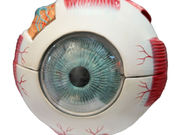Second harmonic generation imaging reveals anterior limbal cribriform layer, presumed anchoring fibers
THURSDAY, Nov. 5, 2015 (HealthDay News) — Two novel collagen structures have been revealed by second harmonic generation (SHG) imaging of the human corneal limbus. The findings were published in the September issue of Investigative Ophthalmology & Visual Science.
Choul Yong Park, M.D., from Ilsan Hospital in Goyang, South Korea, and colleagues report novel findings of the human corneal limbus by using SHG imaging. An inverted two-photon excitation fluorescence microscope was used to image the corneal limbus. For the corneal limbal area, multiple, consecutive, and overlapping image stacks (z-stack) were acquired.
According to the researchers, SHG imaging revealed two novel collagen structures: an anterior limbal cribriform layer and presumed anchoring fibers. The anterior limbal cribriform layer was located between the peripheral cornea and Tenon’s/scleral tissue, and was an intertwined reticular collagen architecture just below the limbal epithelial niche. High vascularity was seen in this structure on autofluorescence imaging. Radial strands of collagen were found to connect the peripheral cornea to the limbus central to the anterior limbal cribriform layer. These presumed anchoring fibers had both collagen and elastin, were more extensive in the superficial versus deep layers, and were not seen in very deep limbus near Schlemm’s canal.
“It’s not every day that one newly discovers parts of the human body,” study coauthor Roy S. Chuck, M.D., Ph.D., of the Albert Einstein College of Medicine in Bronx, N.Y., said in a Research to Prevent Blindness news release. “What makes this finding extra interesting is the proximity of these new structures to a stem cell region where we already perform limbal stem cell transplants to replenish the corneal epithelium when it is lost to disease or injury.”
Full Text (subscription or payment may be required)
Copyright © 2015 HealthDay. All rights reserved.








